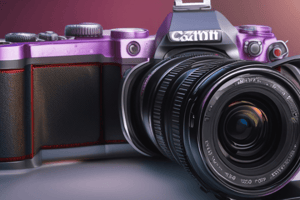Podcast
Questions and Answers
What is photography the science, art and practice of?
What is photography the science, art and practice of?
- Creating durable images by recording light or other electromagnetic radiation (correct)
- Creating durable images by recording pressure
- Creating durable images by recording sound
- Creating durable images by recording temperature
What is used to focus light reflected or emitted from objects into a real image?
What is used to focus light reflected or emitted from objects into a real image?
- A mirror
- A lens (correct)
- A prism
- A filter
What produces an electrical charge at each pixel in an electronic image sensor?
What produces an electrical charge at each pixel in an electronic image sensor?
- Temperature changes of objects
- Sound waves from objects
- Light reflected from objects (correct)
- Pressure changes of objects
What was the primary use of photography for scientists like Eadweard Muybridge?
What was the primary use of photography for scientists like Eadweard Muybridge?
What is the result with photographic emulsion?
What is the result with photographic emulsion?
What was the first type of camera used in journalism and sports photography?
What was the first type of camera used in journalism and sports photography?
What is traditionally used to create a positive image on a paper base?
What is traditionally used to create a positive image on a paper base?
What is the primary component of a digital camera that captures light?
What is the primary component of a digital camera that captures light?
What is an important difference between digital and chemical photography?
What is an important difference between digital and chemical photography?
What is the purpose of the camera or 'camera obscura'?
What is the purpose of the camera or 'camera obscura'?
What is used in analogue cameras?
What is used in analogue cameras?
What is the output of a digital camera before processing?
What is the output of a digital camera before processing?
In which fields is photography employed?
In which fields is photography employed?
What is high-speed photography used for?
What is high-speed photography used for?
What was the primary use of photography for artists in the pictorialism movement?
What was the primary use of photography for artists in the pictorialism movement?
Why is the subject being photographed required to be illuminated?
Why is the subject being photographed required to be illuminated?
Flashcards are hidden until you start studying
Study Notes
Definition of Photography
- Photography is the science, art, and practice of creating durable images by recording light or other electromagnetic radiation.
- It involves recording light using a light-sensitive material (such as photographic film) or electronically using an image sensor.
Camera and Image Processing
- A lens is used to focus light onto a light-sensitive surface inside a camera during a timed exposure.
- An electronic image sensor produces an electrical charge at each pixel, which is processed and stored in a digital image file.
- In film photography, a latent image is created, which is later developed into a visible image.
- Digital imaging uses an electronic image sensor to record images as electronic data, allowing for image post-processing.
History of Photography
- 19th century: Studio cameras used plates.
- 1900: Box cameras, one of the first mass-produced pocket cameras using film.
- 1922: Compact Kodak folding camera.
- 1932: Leica-II, one of the first 135 film cameras.
- 1949: Contax S, the first pentaprism SLR.
- 1975: Polaroid Colorpack 80 instant camera.
- 2000: Digital camera, Canon Ixus class.
- 2000: Nikon D1, the first digital SLR used in journalism and sports photography.
- 2010: Smartphone with built-in camera spreads private images globally.
Uses of Photography
- Scientists use photography to record and study movements.
- Artists use photography to explore avenues beyond photo-mechanical representation of reality.
- Military, police, and security forces use photography for surveillance, recognition, and data storage.
- Amateurs use photography to preserve memories, capture special moments, tell stories, send messages, and for entertainment.
- High-speed photography visualizes events too fast for the human eye.
Technical Aspects
- Photographers control the camera and lens to expose light recording material to form a latent image or RAW file.
- Digital cameras use electronic image sensors based on CCD or CMOS technology.
- The resulting digital image is stored electronically, but can be reproduced on paper or film.
- The camera is a dark room or chamber from which all light is excluded except the light that forms the image.
Studying That Suits You
Use AI to generate personalized quizzes and flashcards to suit your learning preferences.




